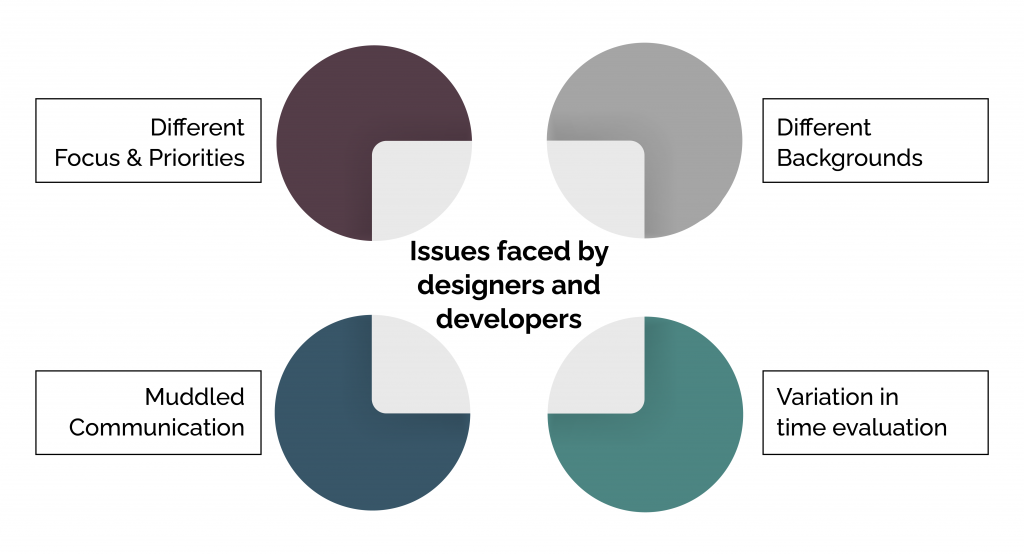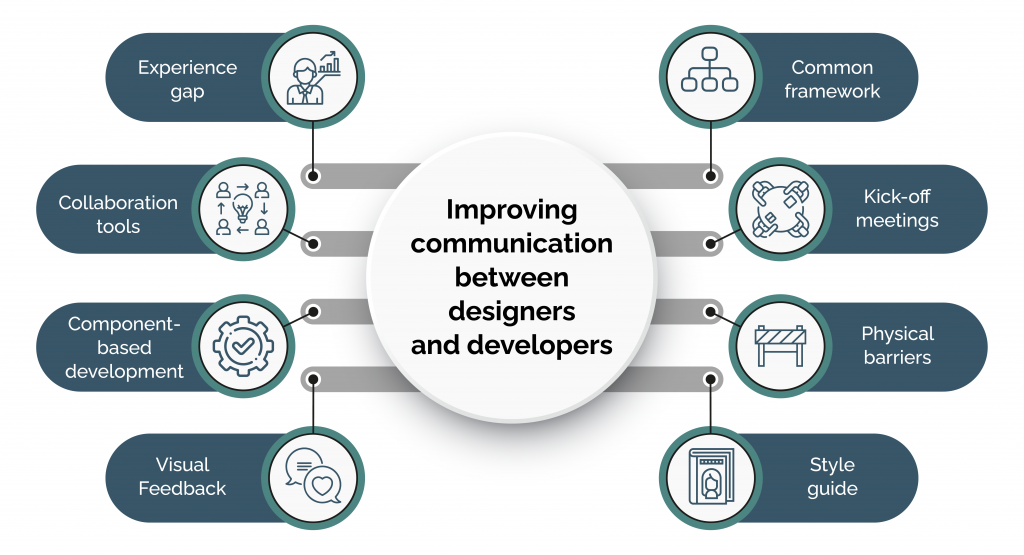In the UX design world, the contributions of designers and developers are equally essential to shaping its success. Good design is not always about the product but the process leading to it. As experts say, when developers and designers work together, magic happens. But this magic can manifest into great designs only if the existing collaborative gaps between these two groups of experts are closed sooner than later. Designers should not limit themselves to sharing specifications, assets, interactions, mockups, etc., with developers. These two professionals must share a common objective that is an exceptional user experience for design intent. Design clarity must be integral to ideation, mockup, wireframing, and prototyping. Finding an optimum solution becomes easier when designers and developers communicate well and collaborate even better. They must strive to educate each other better and learn at the same time. Cross-functional knowledge and a dynamic approach are pivotal to a great collaboration. As remote collaboration is the new way of working today, we’ve moved from colorful post-its to email reminders and whiteboard sessions to video calls. Therefore, designers and developers must accustom themselves to better and powerful ways of collaborating and communicating. This blog gives you insights into the challenges of designer-developer collaboration and tips on how to improve it.
What is designer-developer collaboration?
Aaron Walters of InVision states, “Designers and developers probably have more in common than they realize.” Designer-Developer collaboration describes a relationship with a shared understanding and objective of producing high-quality and functional UX designs. While designers only think about design systems, developers need to focus on simplifying modular code. But the way the processes are executed may be slightly different. This is where a common ground for collaboration and communication helps. They could use various collaboration tools during different phases or take advantage of other collaboration mechanisms mentioned in this blog. Before we delve deeper, let us highlight the benefits of seamless designer-developer collaboration.
- Designers and developers can gain familiarity with the design, processes, and other person’s ways of working, which helps them contribute to tasks more effectively.
- With a common strategy, design, and execution, both teams can decrease their learning curves and deliver faster.
- It helps create a healthy and conducive collaborative environment where team members can take complete ownership of their work.
- Collaboration provides new learning experiences to implemented individual tasks. This enriches their thought processes and improves project engagement.
- Working as a close-knit team helps nurture a healthy working environment, improve problem-solving, and lead to more valuable contributions.
- Revenue goals are met faster if there is no blame game and deliverables are rolled out more quickly without compromising quality.
The advantages mentioned above help address the following collaboration pain points. It is often difficult for designers to work with developers and vice versa because of distinct backgrounds, mindsets, and approaches, leading to ego clashes or stalled work. Both designers and developers may need to work together and complete projects such as website designs, product interfaces, mobile app revamp, and digital marketing campaigns. However, despite working together, there is always some disconnect between the two teams. Here are some role-based pain points that both teams need to address for seamless collaboration and positive results.

- Design is about aesthetics and dimensions, while development is about functionality, usability, and scalability.
- Designers shape the product while developers bring them to life. A lack of understanding about the intent of a design causes disparities, misunderstandings, and disagreements.
- Design is about the finer details, and developers have an eye for detail. If elements and features are undiscussed with the developers, the result is a product disaster.
- Unnecessary back and forth loops take place due to a lack of cross-domain understanding. This wastes a lot of bandwidth and delays the QA process.
- Design is evolving, and the lack of constant updates can put teams behind and cause confusion instead of clarity.
Challenges in designer-developer collaboration
Despite being critical players in UX design, designers and developers often remain isolated and siloed with limited communication. This raises the following challenges.
Variation in time evaluation: UX designing cannot be done overnight. Designers need to consider layout, user interface, design aesthetics, user experience, and much more. However, designers commonly make haphazard and wrong time estimations leading to a time crunch for developers to build these designs.
Inclusion of developers towards the end: Involving the development team when the process is done leads to complex, chaotic processes and severe setbacks.
Lack of mutual consideration: From the kick-off to the delivery stage, designers’ planning that includes defining timelines, tasks, design, development, and collaboration methods usually does not involve the developer’s point-of-view. Similarly, developers rarely pitch in designers when they develop prototypes and get them tested. This leads to disagreements and significant rework later.
Misconceptions about UX design work: For many developers, design work is perceived as an extra burden. This comes from a lack of understanding of the science behind UX design. Making an aesthetic and helpful interface must include multiple prototypes to understand the designer’s perspective as well.
Muddled communication: Good communication is the foundation of a great UX design. Effective communication eases the process and the road to the final product. Unfortunately, most designers and developers draw a line between their teams and don’t practice the proper communication techniques. While developers are bound to talk technicalities and code specifics, the designers prefer talking about creative ideas and the beauty of the design. This causes misunderstandings and process slowdown.
Wrong implementation due to misunderstood design or complex handover: A design handoff occurs when the design and prototypes have been tested and are being handed off to developers to start coding. A complicated or unclear handover is a developer’s worst nightmare. And writing a novel-length specifications PDF is not ideal either. Using collaborative tools during different phases of design development is highly beneficial.
Ways to Improve communication
Experts recommend the following tips to improve designer-developer communication.

Kick-off meetings: These icebreaker meetings must take place between designers, developers, and clients. This way, vague discussions and conversations are avoided to obtain clarity. For example, designers should not hold back explaining the exact design to the developers. Similarly, developers must coordinate with designers to replicate their designers in the best way. Kick-offs help exchange visions of design and development, communicate the challenges, and derive solutions.
Avoiding assumptions and talking about processes: Designers and developers have their respective product assumptions. Both teams should start communicating earlier and zero in on the core problem or requirement to avoid discrepancies. Also, developers must clear their doubts about design to come up with the best solutions. Effort estimations and plan B must be discussed openly and confirmed mutually. This saves the time spent is unraveling mysteries and course corrections later in the design process.
Frequent testing and designer feedback: Designers must prepare sketches or virtual prototypes and continuously share them with the developers for feasibility study and feedback. Similarly, developers must focus on user experience improvements, frequent user testing, and design validation from designers. They need to measure the design usability from the designers’ point of view. Tools like zipBoard, Notable, and Usabilla are handy for this.
Unleash the common framework: Designers and developers often use different frameworks for a joint project based on their requirements. Since these frameworks differ significantly, it usually leaves both departments frustrated. Common frameworks like Bootstrap are now available to help developers and designers stay synchronized and rapidly build web applications or websites. Adapting to a common framework helps reduce complexities while saving time and effort.
Making each other’s lives easier
What should designers do?
- Reuse design components and views when possible.
- Maintain color palettes, design elements, icons, etc., uniformly to reduce distractions.
- Utilize grids and breakpoints to improve design responsiveness when it is coded.
What should developers do?
- Understand design intent and motivations and put them into practice.
- Gain essential knowledge about graphic design and participate actively in design discussions.
- Engage in design brainstorming sessions to clarify what can be developed and what can’t.
- Try and evaluate the evolving design from a functional viewpoint to reduce rework and delays.
Proven ways to improve collaboration
Common focus on the end-user: Following a common goal like user experience through usability testing helps designers and developers perform better and empathize. The Nielsen Norman Group gives us a checklist on usability testing for both designers and developers.
Collaborate from the beginning: A recent study by the Department of Industrial Engineering and Management at the University of Oulu in Finland concluded that early collaboration leads to:
- Fewer chances of producing inferior products
- Greater satisfaction for the end-user with regards to functionality and usability
- Room for improved solutions and
Standardize operations and processes: A standardized order of operations and processes helps speed up work and steer clear of any miscommunication. Clarity on the common oversights like naming conventions, sizes, margins, paddings, etc., for designers and developers, helps reduce logistical issues. When it comes to systems and processes, a thorough checklist can help teams stay focused, take ownership, and complete crucial tasks before moving on to the next design development phase.
Frequent check-ins: This does not mean micro-management but ensuring that all the stakeholders are on the same page regarding the project progression. By having frequent check-ins between designers and developers, you’re able to keep the project moving along by removing communication and interpretation bottlenecks.
Implementing collaboration tools
Developers often wait on the design team to deliver sample designs and then proceed with the development. This method is simply not practical. Tools like Zeplin and InVision improve collaboration efforts with better transparency and direction. In addition, collaboration tools can be used in different phases of design development. Here are some excellent tools both designers and developers can use.
Mockplus cloud is an all-in-one collaboration and handoff tool for designers and developers to prototype, collaborate, and handoff designs in one place. The features include:
- Design imports with assets from Sketch, Photoshop, Adobe XD, and Figma.
- Upload prototypes from Justinmind, Axure, Mockplus, and documents.
- Create UI flows and interactive prototypes using drag-and-drop.
- Comment, test, review, and iterate designs with simple clicks.
- Inspect, copy and download design specifications, assets, and code.
Zeplin is a design handoff tool that helps translate your designs into CSS, Swift, Android, Objective-C, or React Native code while also exporting layers and marked assets. The key features include:
- Integrates with Sketch, Figma, Photoshop, Jira, Slack, and Trello.
- Generates RGB and HEX values for your designs.
- Provides buttons, layers, and icons with marked assets.
- Supports iOS, Android, and web platforms.
Cage is an online media collaboration tool that allows designers and developers to share and present workflows for creative review. Cage helps you plan and complete projects with a unique mix of tools. With all of your team’s tasks, discussions, files, and activities in a single location, the status of projects and team performances are transparent on this platform. The core features include:
- Access controls and permissions.
- Communication Management.
- Content management.
- Comments and feedback.
- Third-party integrations.
- File sharing.
- Drag and -drop.
Invision provides insightful feedback through clickable design prototypes on native devices. It prevents the need for static PDFs or oversized sitemap-style documents. Instead, real-time comments and feedback help designers and developers resolve issues sooner. The other features include:
- Link sharing to view designs in the browser or on a mobile device.
- Real-time screen-sharing of projects and meeting with LiveShare.
- Conversation organization around design component specifics using threaded comments.
- Daily feedback emails, comment feeds Sort by date, screen, read, unread, and more, activity feeds and follow-ups.
- Password protection for designs.
- Easy browser, drag and drop, and automatic sync through Dropbox integration.
- Upload PNG, JPG, PDF, or GIF files for feedback using any low and high-fidelity designs design tool.
Bitrix24 is a collaboration workspace that helps handle daily operations & tasks. It is used primarily for CRM, Project Management & Collaboration in the Cloud or on-premise. The key features include:
- Collaboration (chats, polls, stream messages, telephony integration, voice & video calls).
- CRM (leads, contacts, invoices, web forms, deals, sales reports automation, open channels integration, website widget).
- Project Management (tasks, subtasks with Kanban, dependency management, recurring tasks & task time-tracking).
- Document Management (file storage & sharing, data synchronization and integrations, and workflows for document library).
- Time Management (task time automatic calculation & summary, reports, shared calendars).
Mural offers a dynamic and virtual environment to share and visualize design ideas. In addition, it helps run productive meetings and workshops in public and private modes. The key features include:
- Easy integrations with Dropbox, Slack, GitHub, and other productivity tools.
- Built-in and ready-to-use templates.
- Enterprise dashboards for performance management, insights, and controls.
- Security protocols, versatile safeguards, and global standards.
- Frameworks to organize content and gain design insights.
- Drag-and-drop images and GIFs.
- Free-hand sketching.
- Build visual stories using icon libraries.
- Shapes and connectors for building diagrams and mapping complex workflows.
- Sticky notes and text for ideas, thoughts, and feedback.
Red Pen is an effective feedback tool that helps designers with constructive criticism on a project. It lets you drag and drop designs into your dashboard and invite specific developers or clients to share their thoughts in real-time as you roll out your latest updates. In addition, red Pen helps keep track of multiple versions, so you don’t lose earlier designs. The key features include:
- Point-and-click to provide feedback.
- Live comments.
- Sharing a private link to a collaborator for feedback.
- Drag states, screens, and alternatives to do a project.
- Version tracking and instant change status updates.
Five foundational principles of designer-developer collaboration
- The developer is your user: Your user will interact with the final product built by developers, based on the design handoff you give.
- The only certainty is change: Design needs to be flexible and scalable, depending on the changing needs of your end-user.
- Design must evolve at every step: As a designer, your work will never be done. So expect use cases and questions from the team while development is ongoing.
- Less is more: When visionary German designer Dieter Rams says less is better, you listen.
- Find your passion and go with it: Empathy and focus are at the helm of a good product design.
Questions designers should ask developers
Before creating your artboard, ask these questions to your development team for better clarity.
What handoff tools are we using? Ensure you and the developer are on the same page for tools based on project needs and team strengths. This will ease the production process.
What asset management strategy are we using? Asset management helps track the components, files, tools, frameworks, and software used in the design process. Clarity and direction in this regard save a lot of frustration.
Do we follow a particular file-naming convention? Many handoff tools do not auto-generate design layer class names. Discussing naming protocols early will save a lot of confusion later.
Do the frameworks/libraries we use put constraints on design/technology? Having an in-depth understanding of Android components and material design will prevent unsolicited rework. Using responsive grids for Sketch artboards based saves a lot of implementation headaches.
How to depict states, micro-interactions, or animations? Interaction design and states are highly dependent. Therefore, developers need to be briefed in the early stages of production, aligning with their individualistic approach.
Outcomes of effective collaboration
- Gaining familiarity with internal teams, expectations, and processes.
- Overcoming fears, gaining clarity and confidence in delivering exceptional designs.
- Learning cross-functional practices that can impact design or development workflows.
- Establishing a good work culture and rapport to improve performances.
- Aligning on the end vision.
Retrospective
Today, technology-based collaboration is the cornerstone of any organizational success. This is no different for designers and developers. However, these two teams often find it hard to reconcile and enable frictionless collaboration. Therefore, it is essential to bridge any communication gaps that hamper an excellent product from becoming a great product. On the brighter side, designers are spending significant time on developer collaboration tools with an engineering mindset. While engineers use tools like InVision to inspect design elements, check specifications, and break down the design system to more specific coding elements.
Are designer-developer collaboration issues impacting your enterprise performance? Connect with the experts at Radiant Digital to adopt the most suitable collaboration techniques for your organization.


